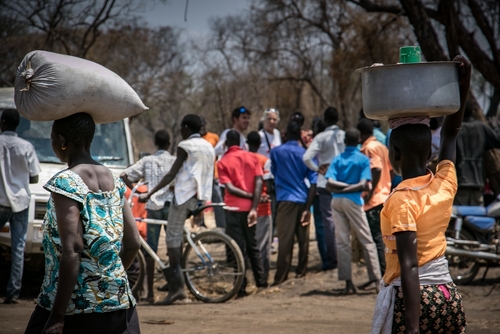“They just slaughter you, whether you’re a man, woman or child. I lost all my brothers and my relatives. Life here is very difficult. With no man, nobody helps you,” says Maria*, who is one of hundreds of thousands of refugees who have fled to northern Uganda since July 2016, following renewed violence in South Sudan. Over 630,000 refugees have since arrived in Uganda and thousands continue to arrive every week, bringing the total number of South Sudanese refugees and asylum-seekers to over 900,000. Uganda now hosts more refugees than any other African country, accepting more refugees than the number who were granted asylum by the whole of Europe in 2016.
While those arriving are in relatively good health, many tell stories of horrific violence in their place of origin or on their journey. The scale of the refugee influx has also pushed Uganda’s progressive refugee policies to their limits, overwhelming reception conditions and the government’s ability to respond.
“Despite the large-scale humanitarian mobilisation, the emergency response is still far from sufficient, and many people have been left with insufficient water, food and shelter,” says Jean-Luc Anglade, MSF head of mission in Uganda. Many newly arrived refugees are forced to sleep under trees, and delays in food distributions and a lack of potable water have even prompted some refugees to return to South Sudan. In addition, despite over 85 per cent of the new arrivals being women and children, and despite widespread reports of sexual violence in South Sudan, there are very few organisations responding to their specific protection needs. “As the flow of refugees shows no sign of abating, a sustained and long-term effort will be needed to assist these people over the next months, if not years,” says Anglade.

In addition to its operations in South Sudan, MSF has been responding to the humanitarian crisis in Uganda since July 2016, with medical and water and sanitation activities. MSF is currently working in four refugee settlements in the northwest – Bidi Bidi, Imvepi, Palorinya and Rhino – providing inpatient and outpatient medical care, maternity care and nutritional care, and conducting community health surveillance and water and sanitation activities. MSF also responded to an influx of refugees into Lamwo, on the border with South Sudan, after an attack in Pajok, Eastern Equatoria, but has since handed over these activities to other organisations.
Access to water is one of the biggest challenges in the refugee settlements and MSF has been scaling up operations in water support. In Palorinya, MSF produces an average of two million litres per day from the River Nile, supporting over 100,000 people. MSF produced a staggering 52 million litres of clean water in Palorinya in April alone.
“There is a never-ending cascade of challenges,” says Casey O’Connor, MSF project coordinator in Palorinya. “We can treat millions litres of water a day but it all needs to be trucked to water tanks in refugee settlements that are 150-250 square kilometres. After heavy rains, many roads become impassable. This leaves tens of thousands of people without water for days. And in the rainy season, if people can’t get clean water, they will resort to using dirty, disease-ridden standing water. This can turn the health status of a population on its head – from relatively healthy to disease outbreak in a matter of days.”
In addition to responding to the refugee influx, MSF runs regular programmes in Uganda providing sexual reproductive health services for adolescents in Kasese, HIV/AIDS care for the fishing communities on lakes George and Edward, and HIV viral load monitoring services in Arua regional hospital.
*Not her real name


